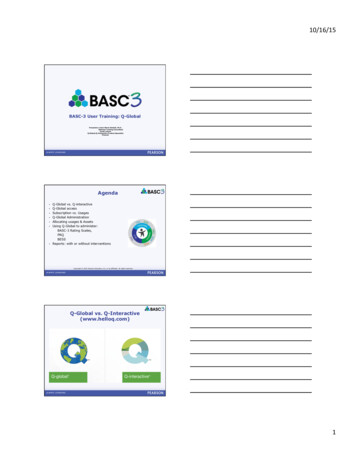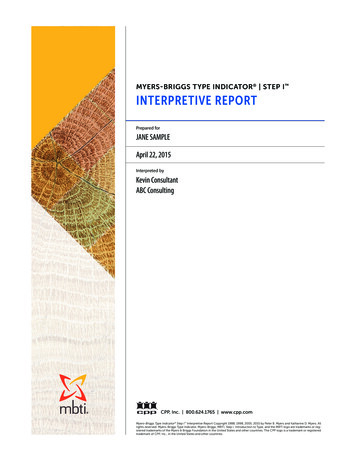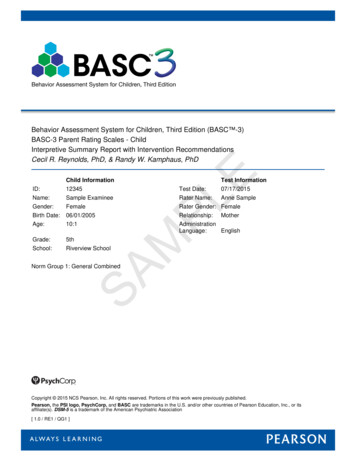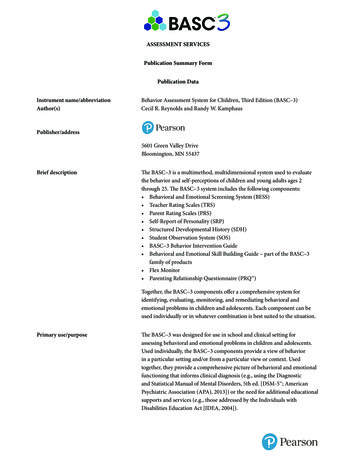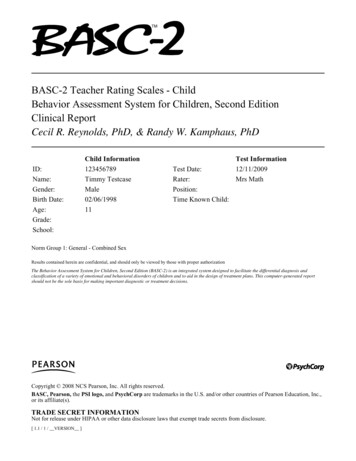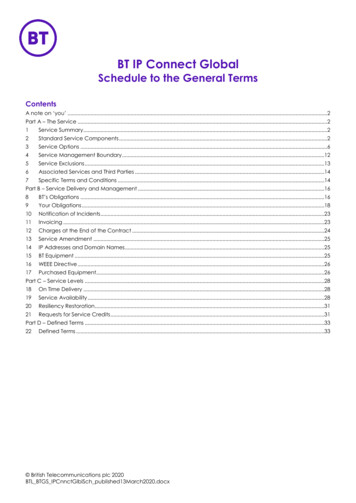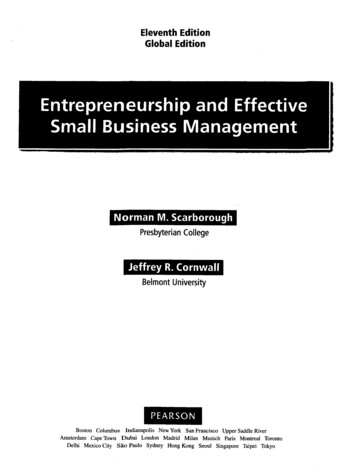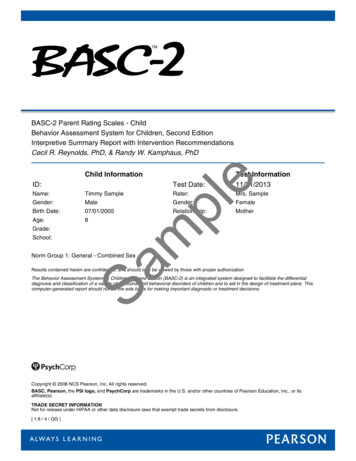
Transcription
BASC-2 Parent Rating Scales - ChildBehavior Assessment System for Children, Second EditionInterpretive Summary Report with Intervention RecommendationsCecil R. Reynolds, PhD, & Randy W. Kamphaus, PhDID:Timmy SampleGender:MaleBirth Date:07/01/2005Age:8Grade:School:Test Date:Rater:Mrs. SampleGender:FemaleRelationship:MothermName:Test Information11/21/2013pleChild InformationSaNorm Group 1: General - Combined SexResults contained herein are confidential, and should only be viewed by those with proper authorizationThe Behavior Assessment System for Children, Second Edition (BASC-2) is an integrated system designed to facilitate the differentialdiagnosis and classification of a variety of emotional and behavioral disorders of children and to aid in the design of treatment plans. Thiscomputer-generated report should not be the sole basis for making important diagnostic or treatment decisions.Copyright 2008 NCS Pearson, Inc. All rights reserved.BASC, Pearson, the PSI logo, and PsychCorp are trademarks in the U.S. and/or other countries of Pearson Education, Inc., or itsaffiliate(s).TRADE SECRET INFORMATIONNot for release under HIPAA or other data disclosure laws that exempt trade secrets from disclosure.[ 1.8 / 4 / QG ]
BASC-2 Parent Rating Scales - Child Interpretive Summary Report with Intervention Recommendations11/21/2013, Page 2Timmy SampleVALIDITY INDEX SUMMARYF IndexResponse w Score: 1Raw Score: 114Raw Score: 10T-SCORE hdrawalAttentionProblemsBehavioralSymptoms IndexAdaptabilitySocial SkillsLeadershipActivities of 654643Adaptive SkillsAggression20HyperactivityGen.-Comb. SexSa20T Score (Plotted)60m5070PercentileGen.-Comb. Sex
BASC-2 Parent Rating Scales - Child Interpretive Summary Report with Intervention Recommendations11/21/2013, Page 3Timmy SamplePRS SCORE SUMMARY: General - Combined Sex Norm GroupComposite Score SummaryRaw ScoreT ScorePercentile Rank90% ConfidenceIntervalExternalizing Problems190659261-69Internalizing Problems164567551-61Behavioral Symptoms Index367649160-68Adaptive Skills244494345-53Composite ComparisonsExternalizing Problems vs. Internalizing ProblemsDifferenceSignificance LevelFrequency ofDifference90.05greater than 25%61Mean T score of the Adaptive Skills Composite49Scale Score SummarypleMean T score of the BSIIpsative Comparison90% ConfidenceIntervalDifferenceSignificance LevelFrequency ofDifference66-78110.055% or less10% or lessT Score177296Aggression6516245-57-100.05Conduct calitySaHyperactivitymRaw ip13494442-560NSActivities of Daily Living18556547-636NSFunctional Communication27504644-561NSWithdrawalAttention ProblemsAdaptabilitySocial SkillsNote: All classifications of test scores are subject to the application of the standard error of measurement (SEM) when making classification decisions. Individualclinicians are advised to consider all case-related information to determine if a particular classification is appropriate. See the BASC-2 Manual for additionalinformation on SEMs and confidence intervals.
BASC-2 Parent Rating Scales - Child Interpretive Summary Report with Intervention Recommendations11/21/2013, Page 4Timmy SampleSCALE SUMMARYThis report is based on Mrs. Sample's rating of Timmy's behavior using the BASC-2 Parent RatingScales form. The narrative and scale classifications in this report are based on T scores obtained usingnorms. Scale scores in the Clinically Significant range suggest a high level of maladjustment. Scores inthe At-Risk range may identify a significant problem that may not be severe enough to require formaltreatment or may identify the potential of developing a problem that needs careful monitoring.Externalizing ProblemsThe Externalizing Problems composite scale T score is 65, with a 90 percent confidence-interval rangeof 61-69 and a percentile rank of 92. Timmy's T score on this composite scale falls in the At-Riskclassification range.pleTimmy's T score on Hyperactivity is 72 and has a percentile rank of 96. This T score falls in theClinically Significant classification range, and usually warrants follow-up. Timmy's mother reports thatTimmy engages in many disruptive, impulsive, and uncontrolled behaviors.Timmy's T score on Aggression is 51 and has a percentile rank of 62. Timmy's mother reports thatTimmy tends not to act aggressively any more often than others of his age.mTimmy's T score on Conduct Problems is 67 and has a percentile rank of 94. This T score falls in theAt-Risk classification range, and follow-up may be necessary. Timmy's mother reports that Timmysometimes engages in rule-breaking behavior, such as cheating, deception, and/or stealing.SaInternalizing ProblemsThe Internalizing Problems composite scale T score is 56, with a 90 percent confidence-interval rangeof 51-61 and a percentile rank of 75.Timmy's T score on Anxiety is 52 and has a percentile rank of 61. Timmy's mother reports that Timmydisplays anxiety-based behaviors no more often than others his age.Timmy's T score on Depression is 59 and has a percentile rank of 84. Timmy's mother reports thatTimmy displays depressive behaviors no more often than others his age.Timmy's T score on Somatization is 53 and has a percentile rank of 66. Timmy's mother reports thatTimmy complains of health-related problems to about the same degree as others his age.Behavioral Symptoms IndexThe Behavioral Symptoms Index (BSI) composite scale T score is 64, with a 90 percentconfidence-interval range of 60-68 and a percentile rank of 91. Timmy's T score on this composite scalefalls in the At-Risk classification range. Scale summary information for Hyperactivity, Aggression, andDepression (scales included in the BSI) has been provided above. Scale summary information for theremaining BSI scales is given next.Timmy's T score on Atypicality is 60 and has a percentile rank of 86. This T score falls in the At-Riskclassification range, and follow-up may be necessary. Timmy's mother reports that Timmy sometimes
BASC-2 Parent Rating Scales - Child Interpretive Summary Report with Intervention Recommendations11/21/2013, Page 5Timmy Sampleengages in behaviors that are considered strange or odd, and he at times seems disconnected from hissurroundings.Timmy's T score on Withdrawal is 58 and has a percentile rank of 81. Timmy's mother reports thatTimmy does not avoid social situations and appears to be capable of developing and maintainingfriendships with others.Timmy's T score on Attention Problems is 67 and has a percentile rank of 93. This T score falls in theAt-Risk classification range, and follow-up may be necessary. Timmy's mother reports that Timmy hasdifficulty maintaining necessary levels of attention at school. The problems experienced by Timmymight disrupt academic performance and functioning in other areas.pleAdaptive SkillsThe Adaptive Skills composite scale T score is 49, with a 90 percent confidence-interval range of 45-53and a percentile rank of 43.Timmy's T score on Adaptability is 46 and has a percentile rank of 33. Timmy's mother reports thatTimmy is able to adapt as well as most others his age to a variety of situations.mTimmy's T score on Social Skills is 44 and has a percentile rank of 28. Timmy's mother reports thatTimmy possesses sufficient social skills and generally does not experience debilitating or abnormalsocial difficulties.SaTimmy's T score on Leadership is 49 and has a percentile rank of 44. Timmy's mother reports thatTimmy, when compared to others his age, demonstrates a typical level of creativity, ability to workunder pressure, and/or an ability to bring others together to complete a work assignment.Timmy's T score on Activities of Daily Living is 55 and has a percentile rank of 65. Timmy's motherreports that Timmy is able to adequately perform simple daily tasks, in a safe and efficient manner.Timmy's T score on Functional Communication is 50 and has a percentile rank of 46. Timmy's motherreports that Timmy generally exhibits adequate expressive and receptive communication skills, and thatTimmy is usually able to seek out and find new information when needed.
BASC-2 Parent Rating Scales - Child Interpretive Summary Report with Intervention Recommendations11/21/2013, Page 6Timmy SampleBASC-2 PRS-C INTERVENTION SUMMARYNote. Information contained in the Intervention Summary section of this report is based on the BASC-2 Intervention Guide,authored by Kimberly J. Vannest, Cecil R. Reynolds, and Randy W. Kamphaus.Primary Improvement Areas HyperactivitySecondary Improvement Areas Conduct Problems Attention Problems AtypicalityAdaptive Skill Strengths NonepleTimmy's score on Hyperactivity falls in the clinically significant range, and probably should beconsidered among the first behavioral issues to resolve. His scores on Conduct Problems and AttentionProblems are also elevated, and may warrant targeted interventions and/or further monitoring to ensureit doesn't worsen.Note that Timmy had a score on Atypicality that is an area of concern. Interventions for this area are notprovided in this report. However, this area may require additional follow up.SaHyperactivitymTimmy's BASC-2 profile indicates significant problems with Hyperactivity, Conduct Problems, andAttention Problems. Based on Mrs. Sample's ratings, Timmy is experiencing problems with thefollowing behaviors:not waiting for turn disrupting others interrupting others having poor self-control Conduct Problemsbreaking rules stealing Attention Problemsstaying focused paying attention listening well Special Note:The full content of the InterventionRecommendations is included inthe actual reports, but does notappear in this sample report.Primary Improvement Area: HyperactivityHyperactivity problems are considered to be one of Timmy 's most significant behavioral and emotionalareas to address. Hyperactivity is characterized as overactivity or excessive task-irrelevant physical (i.e.,
BASC-2 Parent Rating Scales - Child Interpretive Summary Report with Intervention Recommendations11/21/2013, Page 7Timmy Samplemotor) movement. Children and adolescents with hyperactivity often make noises at inappropriate times,leave their assigned seats without permission, and talk during times designated for silence in theclassroom. Hyperactivity problems can occur alone or can co-occur with attention problems and areusually exhibited by children in both home and school settings. Functional Assessment Contingency Management Parent Training Self-Management of Hyperactivity Task Modification Multimodal InterventionspleThere are a variety of interventions that have been shown to reduce, or have shown promise forreducing, hyperactive behavior, including:Detailed summaries of the Contingency Management and Self-Management intervention strategies areprovided below. See the BASC-2 Intervention Guide for additional detail about these strategies, alongwith the other intervention strategies listed above.mHyperactivity Intervention Option 1: Contingency ManagementSaIn contingency management for hyperactivity, behavioral interventions are used to modify consequentevents (i.e., events that occur after the behavior) that are often maintained through the reinforcement ofoveractive and impulsive behavior. The goal of contingency management is to decrease activity levelsthat negatively impact learning by shaping the child's existing behavior and providing opportunities forthe new, desired behavior to become internalized. The procedural steps for incorporating contingencymanagement strategies into the treatment of hyperactivity are summarized below. See the BASC-2Intervention Guide for a detailed discussion of this topic.Procedural steps for the application of contingency management1. Define the behavior in operational terms.2. Determine the behavioral goals.3. Determine the reinforcers.4. Explain the system to the child.5. Implement the chosen reinforcement strategy (e.g., token system).6. Adjust the reinforcement as needed.Considerations When Implementing a Contingency Management Intervention StrategyFor Teaching. Teachers are generally adept at procedures that involve classwide prompting oracknowledgement and may need only minimal coaching to be more effective with students withhyperactivity. Some issues that typically frustrate teachers include the modification of systems, theimmediacy of reinforcer use, the consistency in application, and the setting of goals that will encourageand change student behavior. Teachers must modify the structure of token economy systems when the
BASC-2 Parent Rating Scales - Child Interpretive Summary Report with Intervention Recommendations11/21/2013, Page 8Timmy Samplestudent loses more points than he or she earns, or students will not maintain an interest or be able toaccess the reinforcer. Reinforcement must be immediate for students with hyperactivity; contingenciesthat are hours, days, or weeks away are unlikely to be effective. Behavioral interventions for studentswith hyperactivity require long-term consistency, and once a student engages in appropriate behaviors,fading may occur but monitoring should also occur so that the intervention can be reapplied whennecessary. Goal setting or criteria setting for access to reinforcers is as critical as immediate access. If astudent is engaging in hyperactive behaviors 90% of the time, a goal of 0% is unrealistic. Goals need tobe seen as gradual, and intermediate steps toward reaching a long-term solution are important forreducing hyperactivity. Goals should also
The Behavior Assessment System for Children, Second Edition (BASC-2) is an integrated system designed to facilitate the differential diagnosis and classification of a variety of emotional and behavioral disorders of children and to aid in the design of treatment plans.File Size: 2MBPage Count: 23
